Garden gnome
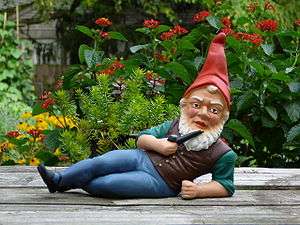
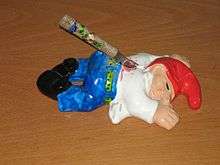
A garden gnome, or lawn gnome, is a figurine of a small humanoid creature, usually wearing a pointy hat, displayed for the purpose of ornamentation on front lawns or in gardens. These figurines originated in 19th-century Germany, where they became known as Gartenzwerge (garden dwarfs). The application of the term gnome in English to this type of garden statue is first attested in the 1930s.
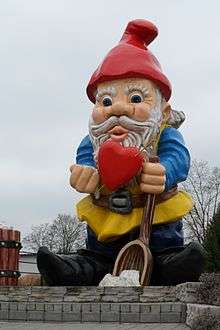
History
Garden statuary has been common in Europe at least since the Renaissance.[1] Among the figures depicted were gobbi (Italian for dwarfs or hunchbacks).[1] In particular, Jacques Callot produced 21 designs for gobbi, engraved and printed in 1616.[1] By the late 18th century, porcelain "House Dwarfs" had begun to be produced, and they remained popular ornaments throughout the 19th Century.[1] In addition, wooden statues of gnomes had been made in Switzerland, around the town of Brienz. Even so, the claim to be the manufacturer of the first garden gnome is hotly contested, but it is possible that Baehr and Maresch of Dresden produced the first ceramic gnomes, having them in stock as early as 1841.[1] From around 1860 onwards, many statues were made in Gräfenroda, a town in Thuringia, Germany, known for its ceramics.[1][2] Philip Griebel made terracotta animals as decorations, and produced gnomes based on local myths about the gnomes' willingness to help in the garden at night. The garden gnome quickly spread across Germany and into France and England, and wherever gardening was a serious hobby.
The manufacturing of gnomes spread across Germany, with numerous other large and small manufacturers coming in and out of the business, each having its own particular style of design. World War II was hard on the industry, and most producers gave up then. Griebel's descendants still make them and are the last of the German producers, all others having moved production to Poland or China. Currently, there are an estimated 25 million garden gnomes in Germany.[2]
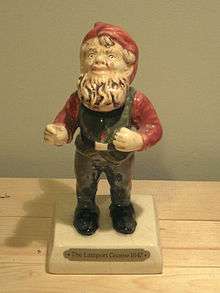
Garden gnomes were first introduced to the United Kingdom in 1847 by Sir Charles Isham, 10th Baronet, when he brought 21 terracotta figures back from a trip to Germany and placed them as ornaments in the gardens of his home, Lamport Hall in Northamptonshire. Only one of the original batch of gnomes survives: "Lampy", as he is known, is on display at Lamport Hall, and is insured for £1 million.[3] A more recent notable manufacturer of garden gnomes was Tom Major-Ball, father of former United Kingdom Prime Minister John Major.
Garden gnomes have become a popular accessory in many gardens. They are often the target of pranks, known collectively as gnoming: people have been known to return garden gnomes "to the wild", most notably France's Front pour la Libération des Nains de Jardins and Italy's MALAG (Garden Gnome Liberation Front). Some "kidnapped" garden gnomes have been sent on trips around the world (the travelling gnome prank; this later became the basis for Travelocity's "Where is my Gnome?" series of advertisements). In 2008, a 53-year-old French man in Brittany was arrested on suspicion of stealing upwards of 170 garden gnomes.[2]
Some scholars have suggested that the garden gnome is a descendant of the Greco-Roman fertility god Priapus, whose statue was often found in ancient gardens.[4][5][6]
Garden gnomes in pop culture and advertisement
A garden gnome plays a certain role in the French-German movie Amélie and the Disney-financed movie Gnomeo & Juliette is all about garden gnomes. The Austrian Socialist Party (SPÖ) used garden gnomes in their campaign for the regional elections in the province of Vorarlberg. The campaign included 20,000 garden gnomes, the so called 'Coolmen' models were equipped with small boards displaying short slogans. The socialist party in this part of Austria always had performed poor in the elections and considered itself to be a political dwarf - hence the 'garden gnome campaign' was also an intended ironic pun. Initially many of the garden gnomes were placed along highly frequented roads. After 400 garden gnomes had gone missing the party reported the offence to the police, the case received some attention in the international media.[7]
Typology
Garden gnomes are typically males, often bearded, usually wear red phrygian caps and often have pipes. They are made in various poses and shown pursuing various pastimes, such as fishing or napping.[8]
Gnomes have become controversial in serious gardening circles in the UK, and have been banned from the prestigious Chelsea Flower Show, as the organisers claim that they detract from the garden designs.The ban was lifted just for 2013 the 100 year anniversary of Gnomes. Gnome enthusiasts accuse the organisers of snobbery because they are popular in working class and suburban gardens.[9]
Gnomes may be made from terracotta clay slip (runny clay) poured into molds. This is allowed to set up and the excess emptied from the centre, leaving a clay shell. The gnome is removed from the mold when firm, allowed to dry and then fired in a kiln until hard. Once cooled, the gnome is painted. More modern gnomes are made from resins and similar materials.[10]
Today, many different variations of garden gnomes exist, including humorous ones like a gnome stabbed in the back or one with an executioner's hood.[11]
Types
 Historical gnomes
Historical gnomes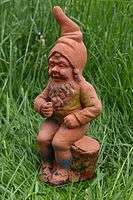 Traditional German garden dwarf
Traditional German garden dwarf Gnome at the Gnome Reserve, Devon, UK
Gnome at the Gnome Reserve, Devon, UK Garden gnome
Garden gnome Garden gnome
Garden gnome Garden gnome with fluffy beard
Garden gnome with fluffy beard_-_Curtiberg_2012-03-15_13-03-18.jpg) Garden gnomes in a window
Garden gnomes in a window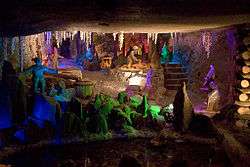 Gnome garden at the Wieliczka Salt Mine
Gnome garden at the Wieliczka Salt Mine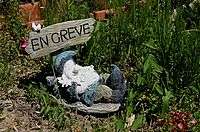 Traditional grey gnome (En grève=On strike)
Traditional grey gnome (En grève=On strike)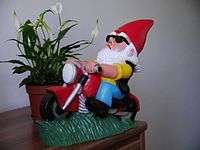 Garden gnome on a motorcycle
Garden gnome on a motorcycle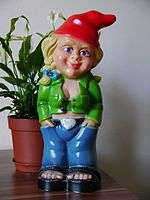 Female garden gnome
Female garden gnome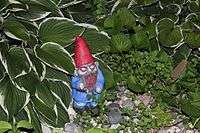 A zombie garden gnome sitting in plants
A zombie garden gnome sitting in plants
See also
- Gnome Reserve
- Garden hermit
- Garden ornament
- Garden gnome liberationists
- Gnomeo & Juliet, a movie with garden gnomes as protagonists
- Kitsch
- Front yard
- WikiGnome, a wiki user who makes useful incremental edits without clamouring for attention.
- Gardengnomeheaven
References
- 1 2 3 4 5 6 Way, Twigs (2009). Garden Gnomes, a History. Shire library. 487. Botley, Oxfordshire: Shire Publications. ISBN 9780747807100.
- 1 2 3 "Gnome bandit caught". Metro. 2008-06-13. Retrieved 2008-06-13.
- ↑ "Gnome Expense Spared". BBC News. 1997-12-01. Retrieved 2007-06-04.
- ↑ Arnott, Peter D. (1970). An Introduction to the Roman World. London: Macmillan. ISBN 9780333090701.
- ↑ Harris, Judith (2007). Pompeii Awakened: A Story of Rediscovery. London: I.B. Tauris. p. 117. ISBN 1-84511-241-5.
- ↑ Lloyd-Jones, Hugh (1991). Greek in a Cold Climate. London: Duckworth. p. 64. ISBN 0-389-20967-8.
- ↑ Bell, Bethany. "Austrian party rues disappearance of 400 garden gnomes". BBC NEWS. BBC. Retrieved 21 August 2016.
- ↑ "Gallery". Gnomeland. Archived from the original on 2007-04-29. Retrieved 2007-09-19.
- ↑ Akbar, Arifa (2006-05-25). "Gnomes spark row over fairies at Chelsea". The Independent. Retrieved 2010-10-11.
- ↑ Griebel, Reinhard (2007). "How a gnome is born". Zwergli from Griebel. p. 9. Retrieved 2009-12-15.
- ↑ "gartenzwerg - Google-Suche". www.google.de. Retrieved 2015-09-19.
External links
 Media related to garden gnomes at Wikimedia Commons
Media related to garden gnomes at Wikimedia Commons
